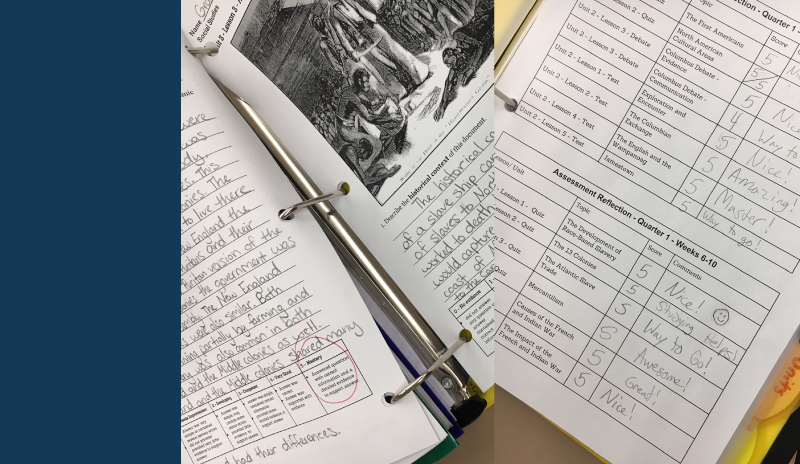
As I’ve become more involved in the teaching community, I’ve noticed a growing tendency towards turning history into a series of craft projects. This issue has been very well documented by Jennifer Gonzalez (Cult of Pedagogy) in an article titled “Is Your Lesson a Grecian Urn?”
Basically, her argument points out that there are many student projects that are fun and engaging. However, if there is no learning taking place, the projects are pointless. As she notes:
“I’ve seen far too many “Grecian Urns”: projects that look creative, that the teacher might describe as hands-on learning, interdisciplinary teaching, project-based instruction, or the integration of arts or tech, but that nonetheless lack any substantial learning for students. What’s worse, because these activities are often time-consuming, they take away from other tasks that would give students the chance to wrestle with more challenging stuff.”
When I see how interactive notebooks are utilized in classrooms, I fear that they’ve trended in this direction.
The general idea behind interactive notebooks is that students are interacting with text. This is how they were originally conceived 15 or so years ago. That alone is a fantastic principle. We want our students deeply thinking about text and analyzing that text.
However, as of late, I’ve often noticed that many interactive notebooks involve significant amounts of cutting, gluing and coloring. This is why my concern over their use has crept in. I have had my students cut, color and/or glue paper on occasion. I like to have them color in the occasional map so that they can see the borders. If they design a visual related to a historical concept, then they should add this visual to a posterboard, along with their thinking, and display it for all to see. However, having my students color just for coloring’s sake? Nah. Nope. Not happening. They can color on their own time, but not as part of a lesson for my class.
Also, many of the designs I’ve seen for interactive notebooks have students cut paper into small shapes that are then meant to be kept for the rest of the year in little pockets or glued down in the books. I’ve worked with seventh graders for the past 16 years. I know what will happen with those small pieces of paper. They’re going to be everywhere! Such a headache. Even if the notebooks were kept in my classroom, I would spend so much of my time and energy making sure that the students kept them neat! I’ve done this in the past. I used to have a more complicated binder system, and the students were responsible for bringing their binders to class every day. I spent so much of my time and energy finding, organizing and rehabbing binders. All for what?
I could have interactive notebooks. I could spend the time and energy towards teaching students to organize their notebooks, keep them organized, and keep track of all the pages. I could even design some really jazzy and creative foldables. I just don’t know why I would. I’m not a new teacher anymore. I have a limited amount of energy these days. I focus that energy on making my students think, and towards pushing their understanding.
I often think about the way in which I’m allocating time in my Social Studies classes. I only have students for about 40 minutes a day, and that time flies by so quickly. If I have my students cutting or gluing or pasting even for one minute a day – that equals almost a week from my school year! I just can’t fathom taking that time away from learning.
Instead, I have the most simple system possible. Binders are kept in the classroom, and students add any handouts to the binder at the end of Unit. They record their assessment grades, and the binder goes back on the shelf. Fast. Simple. Easy. More time is left for learning.

I’ve also noticed that interactive notebooks are sometimes graded for completion. As I have transformed my classroom towards standards-based grading, a completion grade would never fit with my grading system. I don’t want my student’s grade to reflect neatness. I want it to reflect their understanding of the curriculum. Therefore, altogether, interactive notebooks just don’t work for me.
I don’t want you to feel like I’m discounting all interactive notebooks, or the thinking that might go with those activities. If you have a system for your interactive notebooks that involves critical thinking, then good, keep it around! I’m not arguing that all interactive notebooks are inherently bad for the classroom, and there’s no reason to throw them out if they’re working for you.
Still, I implore you to think about what you’re really teaching in your History classes. History is so important. It is who we are as people. It is what we have believed, and what we believe now. It teaches students to think about all the information they see, read and hear on a daily basis. As James Baldwin once wrote, ” The great force of history comes from the fact that we carry it within us, are unconsciously controlled by it… History is literally present in all that we do.”
It’s simply too important to waste the time we have with our students on cutting, pasting and coloring, without combining those activities with thinking.
I’m sure there are a few of you that strongly disagree with my point of view. I get that! We all have our own methods that we love. Tell me why do you love interactive notebooks? How do they encourage learning in your classroom?

2 Responses
I’m planning on using composition books next year as an organizational strategy – how do you have students organize notes and handouts? Your argument is spot on, though – it seems like such a time waster to do so much cutting/coloring (I can’t even IMAGINE what my room would look like, nor can I imagine all of my 7th graders with scissors and gluesticks…).
I have a SIMPLE binder system! I blogged about there here. https://peacefieldhistory.com/students-binder-organization-system/